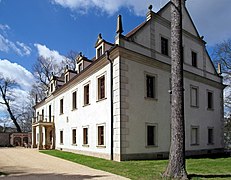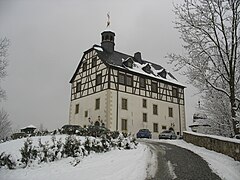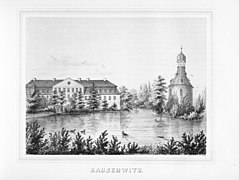Watzdorf (noble family)
The von Watzdorf family (also von Watzdorff ) is a Thuringian , later baronial and since 1719 counts noble family .
history
The name of Watzdorf first appeared in a document in 1137 on the occasion of the enfeoffment of the knight and bailiff Conradus de Wazdorf on the Greifenstein with the nearby village of Watzdorf by Count Sizzo III. from Schwarzburg. The family's earliest possessions were in large numbers, mostly on both sides of the Saale, including the ancestral seats of the two main lines of the family in Altengesees and Neidenberg.
Over the centuries, the family spread in the Thuringian-Saxon area with further emphasis in Vogtland , in the wider area of Leipzig and in Upper Lusatia . Only in the 19th century did it acquire real estate in Silesia and temporarily in West Prussia .
Numerous family members of those von Watzdorf were active in the Saxon civil service, including Count Christoph Heinrich von Watzdorf (1670–1729), cabinet minister under August the Strong and his son Christian Heinrich Graf von Watzdorf (1698–1747). His promising career (1720 Chamberlain, 1724 Court and Justice Council, 1725 Envoy Extraordinary to the courts in Parma and Florence) ended immediately after Friedrich August II took office due to his resistance to the arbitrary rule of his Prime Minister Count Heinrich von Brühl . He came to the Königstein Fortress as a prisoner of state, where he died after 14 years in prison; his property was confiscated after his death.
Another member of the family, Werner von Watzdorf , was Saxony's finance minister from 1895 to 1902.
The family is also isolated in the Vogtland-Franconian area. Emerentia von Watzdorf died on March 10, 1560 on Gut Nestelreuth near Naila . After 1547 the Watzdorf also owned an estate in Feilitzsch . They were related to the Wildenstein and Sparneck families, among others .
The family has been back in Saxony since 2004, at Heynitz Castle near Nossen.
Owned by the Watzdorf family
Lichtenwalde Castle
In 1719, the Saxon army chief and de facto Prime Minister Jakob Heinrich Graf von Flemming bought the indebted Lichtenwalde castle owned by von Bünau and sold it in 1722 to the cabinet minister, Count Christoph Heinrich von Watzdorf (1670–1729), who had the remains of the old castle and Harrasschen The castle was demolished and a large baroque castle was built in its place. His son Friedrich Carl von Watzdorf († 1764), a brother of the later disgraced Minister Christian Heinrich , had an extensive park laid out around the building from 1730.
When Watzdorf died without descendants, Lichtenwalde came into the possession of his widow, Henriette Sophia, née Countess Vitzthum von Eckstädt, in 1764. The Counts Vitzthum von Eckstädt remained lords of the castle in Lichtenwalde until they were expropriated in 1945.
Wiesenburg Castle
By marrying Luise Sophie von Lindau, daughter of Adam Friedrich Brand von Lindau , Schloss Wiesenburg in Fläming came into the family. In the 18th century , Adam Friedrich August von Watzdorf , the electoral Saxon chamberlain, councilor of appeal , court judge in Wittenberg and tax collector of the spa district , was the owner of the castle. This received its current appearance from 1863 onwards during a radical redesign in the neo-renaissance style under his great-grandson Curt Friedrich Ernst von Watzdorf , who also created the 123 hectare park. In 1881 the castle was inherited in the female line.
Dornburg castles

The renaissance castle among the Dornburg castles was built in 1539 by Volrad von Watzdorf in place of a manor house built in the 14th century. Because the owner was overindebted, the castle was sold to Duke Johann Wilhelm von Sachsen-Weimar in 1571.
Other possessions
- Dryfels Castle in Berga / Elster (1592 to 1870)
- Birch heather
- Crostau (from the 2nd half of the 17th century)
- Dinglinger's vineyard (1st half of the 20th century)
- Jößnitz Castle , Saxon Vogtland
- Kauschwitz near Plauen
- Liebertwolkwitz near Leipzig
- Nudersdorf (1840 to 1849)
- Röttis , Saxon Vogtland
- Spreewiese near Görlitz (from 1840)
- Stedten (? Until 1721)
- Störmthal (from 1824)
- Why
coat of arms

The coat of arms is split in gold and black. On the helmet with black and gold covers, a black and a gold buffalo horn, which are decorated with four natural peacock mirrors, each made of three feathers.
In Johann Siebmacher's coat of arms from 1605, those of Watzdorf appear among the nobility from Meißen . The coat of arms is mirrored there.
Personalities
- Daniel von Watzdorf , appointed Tobias Adami as a Preceptor in 1604
- Christoph Heinrich von Watzdorf (1670–1729), imperial count, from 1726 registrar of Pförten
- Christian Heinrich Reichsgraf von Watzdorf (1698–1747), chamberlain as well as court and judicial councilor at the court of Electoral Saxony
- Friedrich von Watzdorf (1753–1809), landowner as well as councilor and court judge in Wittenberg
- Karl von Watzdorf (1759–1840), Saxon general and diplomat
- Otto von Watzdorf (politician) (1801–1860), German lawyer and politician, member of the Frankfurt National Assembly
- Otto von Watzdorf (District Administrator) (1841–1898), German landscape director and district administrator
- Christian Bernhard von Watzdorf (1804-1870), lawyer and Saxon-Weimar minister, founded the yearbooks for Saxon criminal law with Gustav Friedrich Held
- Rudolph Friedrich Theodor von Watzdorf (1804–1880), German manor owner and politician, MdL
- Werner von Watzdorf (1836–1904), Royal Saxon Finance Minister (1895–1902)
- Curt von Watzdorf (1839–1881), landowner and parliamentarian, Member of the Bundestag, Member of the Bundestag
- Hans von Watzdorf (1857–1931), Saxon lieutenant general
- Bernhard von Watzdorf (1860–1921), Saxon lieutenant general
- Erika von Watzdorf-Bachoff (1878–1963), German writer
- Anna Dorothee von Watzdorf (1890–1956), German librarian and author
- Erna von Watzdorf (1892–1976), German art historian
For further relatives see also the lists of the members of the Saxon State Parliament (I. Chamber)
literature
- Yearbook of the German Nobility , Volume 3, 1899, published by WT Bruer, p. 734 - digitalized
- Christian Heinrich von Watzdorf : Hist. Genealogical description of the ancient noble family Derer von Watzdorf 1740 , revised, continued and reproduced. by F. Nitze, Dresden 1872, then Lommer 1884, digitized
- Camillo von Watzdorf : History of the family von Watzdorf , Dresden 1903
- Adam von Watzdorf : History of the von Watzdorf family , 3 volumes, 1985
- Genealogical handbook of the nobility , Adelslexikon Volume IV, Volume 134 of the complete series, CA Starke Verlag, Limburg (Lahn) 2004, ISSN 0435-2408
- Matthias Donath , Black and Gold: The von Watzdorf family in Thuringia, Saxony and Silesia. Nobility in Saxony Vol. 6, ed. by Lars-Arne Dannenberg and Matthias Donath, Meißen 2015.
- Christian Heinrich von Watzdorf: Rath, Hof- u. Forstmeister zu Untern-Greiz historical-genealogical description of the ancient noble and count. Family of those von Watzdorf 1740: fd member d. Closed next to e. lithographed Kt. D. Watzdorf'schen Güter , Petzold, Dresden 1872 digitized
Individual evidence
- ↑ The story of Marlesreuth .
- ↑ ON THE HISTORY OF THE COMMUNITY AREA FEILITZSCH ( Memento from October 7, 2007 in the Internet Archive )
- ^ Alban von Dobenck : History of the extinct family of the von Sparneck (part 1) ; In: Archives for the history of Upper Franconia 22.3 (1905); Pp. 1-65.








